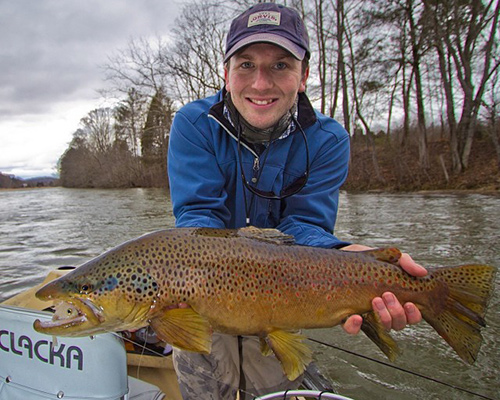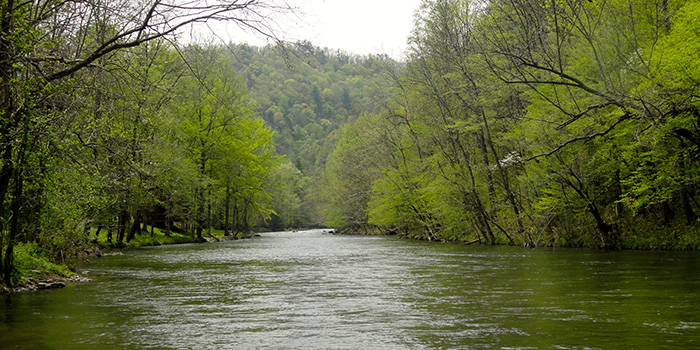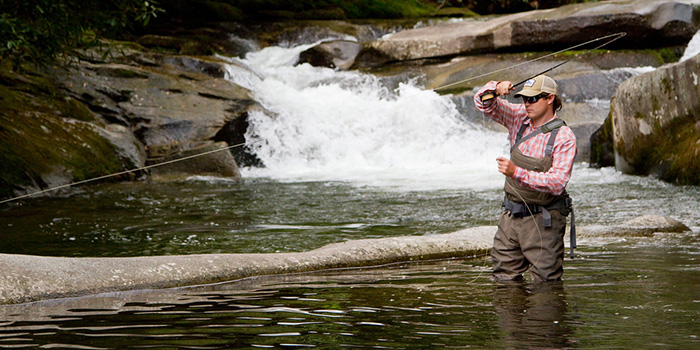Late spring, before the temperatures turn stupefying, bring some of the year’s best angling, with fish ready to gorge on the season’s hatching insects. So, throttle back your time at the office and hit any of these five Southern fly-fishing spots, beginning in the Appalachians and continuing toward the coast.
The South Holston River, near Bluff City, Tennessee
Tucked alongside the base of Holston Mountain, in northeastern Tennessee, the South Holston River offers 14 miles of water primed for drifting and unrivaled quantities of 20-plus-inch stream-born brown trout. Ace guide Patrick Fulkrod, of Mountain Sports Ltd., recommends a CDC sulphur comparadun pattern during the sulphur-mayfly hatch and a black-and-copper-zebra midge through the rest of the season. As far as fishing a particular portion of the South Holston, Fulkrod says the river is top tier anywhere from where it starts, at the South Holston Dam, to where it concludes, at Boone Lake; although, he jokes, “My favorite section is where there are no other anglers!”

Jesse Cheers
The Little River, near Townsend, Tennessee
The Little River spans more than 50 miles in East Tennessee, but the stretch near its source, at Clingmans Dome, is among the most pristine and bountiful waters in the Great Smoky Mountains for hooking native brook trout. In fact, the variety of brookies in Southern Appalachia is genetically distinct from their Northeastern brethren, which makes catching them only that much more of a treat. Guide Josh Pfeiffer, of Frontier Anglers (who regularly updates his blog, so you can know what’s taking), recommends a parachute Adams or a brown stonefly, but he’s quick to note that staying obscured should remain an angler’s primary concern when fishing the Little River. “Since it’s wider than most streams in the park, there aren’t as many hiding places,” he says. “Wearing natural colors, or even camo, and crouching will help not spook the fish.”

Frontier Anglers TN
The Davidson River, near Brevard, North Carolina
It’s no surprise why the Davidson, in the mountains of Western North Carolina, is among the most celebrated rivers south of the Mason–Dixon Line: it boasts more massive rainbow trout than likely anywhere else in the region. The river’s slow, clear currents and accessible streamside don’t hurt, either; however, don’t assume that just because there’s a lot of fish in the water that you won’t have to fight for them. Rainbows in the Davidson are notoriously picky and keen at identifying fishermen’s flies. Local guide Brown Hobson, who was named Orvis’ 2015 Guide of the Year, favors a bead-head soft-hackle pheasant-tail fly in early spring but switches to an inchworm pattern as the weather warms. “The trout are hard to catch,” he admits. “But when I know I’m in a spot that holds them, I’ll camp out for a while and change flies and tactics until I figure out what they want to eat; once that happens, I’ll land several.”

Beth Grant
The Savannah River, near Augusta, Georgia
If you’ve had your fill of chasing trout, the Savannah River teems with an array of fish difficult to find elsewhere in one body of water: bluegill; hybrid bass; largemouths; redeyes; smallmouths; stripes; sunfish; yellow perch; and, yes, trout, too. The Savannah spills from Lake Hartwell and slinks across the state to the coast, but the seven miles of wadeable shoals north of Augusta comprise its best fishing, especially in the spring once the river’s flow begins to ebb. For easy access, park at the Eisenhower Athletic Center & Park and follow the trail to the riverside, but, before you do, swing by Rivers & Glenn Trading Co. and let the good folks there help you pick out the right fly pattern for what you want to nab. Master fly-fishing scribe Ray Bergman once wrote, “It is a good rule always to blame yourself if you have poor luck,” and when fishing the Savannah, with its many species and opportunities to bring a prize to hand, consider that sound advice.

Sir Mildred Pierce/Flickr
The Ashley River & Charleston Harbor, near Charleston, South Carolina.
The vast saltwater flats that wrap Charleston, South Carolina, provide anglers ample opportunities to wrestle the schools of redfish that haunt them. But, as any coastal fisherman can attest, there’s a good way to fish the flats and an awful way: good involves catching fish and staying comfortable; awful results in stomping through pluff mud and chest-high, itchy grass and coming home empty-handed. Captain Harry Demosthenes, of Drum Runner Charters, has fished the waters around Charleston for 25 years and knows how to accomplish the former. He scouts for flats with hard bottoms, low grass, and moves among spots after catching a fish or two in each. Likewise, to hook a red in the spring, he employs crab and spoon patterns, casting in front of roving schools and slowly retrieving the fly. As the water temperatures rise throughout the season, he transitions to baitfish patterns, such as a Clouser minnow. Besides that, though, his advice is straightforward: “Wait to get a good cast in. Don’t rush it.”

Ann Millspaugh/Flickr
JR Sullivan is from Franklin, Tennessee, and is an editor for Field & Stream.







